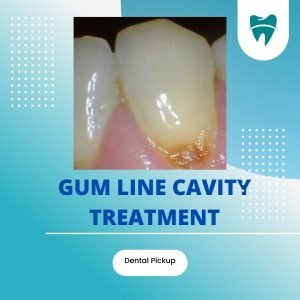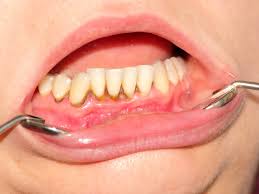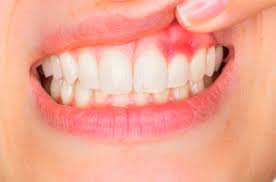
In the area between the teeth and the gums, a cavity is known as a “gum line cavity” may form. Smooth surface cavities and root cavities are also included in the term “gum line cavity.”
The smooth crown surface of a tooth might develop cavities when the gum line is affected. Root cavities, on the other hand, are formed when a tooth’s root is infected by a cavity. Some people’s crowns and roots of teeth might get infected by gum-line cavities.
Gum line cavity treatment
The therapy required is affected by the location of a gumline cavity. As long as it is above the gum line and not too extensive, your dentist may treat it with a filling similar to any other surface category. The most typical procedure is to drill through the tooth’s enamel and then remove the decay.
This is accomplished by filling the hole with composite resin or other materials and then curing it to firm it. A cavity that goes beyond the gum line, on the other hand, usually necessitates more extensive care. You may require a root canal to eliminate the rot and prevent it from spreading.
Prevent tooth decay along the gum line.
You can avoid having cavities if you understand what causes them and how to avoid them. What is the most important thing you can do?
Use a toothbrush to clean your teeth. The American Dental Association (ADA) suggests brushing your teeth twice a day using fluoride toothpaste to prevent cavities. Brush your gumline thoroughly with fluoride mouthwash.
Floss every day. Brushing your teeth twice a day might help eliminate food particles that have become lodged in your mouth. The American Dental Association (ADA) recommends that you floss down to your gum line to remove any bacteria that could lead to cavities.
Visit The office of your dentist. You should see a dentist twice a year to stay on top of what’s going on in your mouth. Early detection and treatment of cavities prevent them from worsening and demanding costly dental work. Your dentist may also provide fluoride treatments.
While under the influence, your dentist may encourage you to use fluoride at home and supply you with a prescription for it.
Dental exams, like any other preventive measure, are critical to your overall oral health. A dental professional can clean your teeth effectively and remove plaque and tartar along the gumline that you couldn’t remove with at-home techniques.
They may look for cavities along your gumline if your gums are receding, which is a potential risk indicator. Nobody wants to be informed that they have a cavity near the gumline.
Learning as much as possible about this type of tooth decay is vital to feeling confident about the procedures your dentist recommends. You can considerably reduce your risk of having a gumline cavity if you practice good dental hygiene and seek your dentist’s counsel.
Causes of gumline cavity
A cavity below the gum line can develop for a variety of reasons.
Plaque: Poor brushing results in plaque collection, a transparent, sticky substance on the teeth. If plaque is not removed, it can harden into tartar, a breeding ground for germs. Bacteria from these species can enter the mouth and cause cavities.
Receding gums can be caused by genetics, age, and plaque, exposing your teeth’ more sensitive root regions. Bacteria can easily attack the softer exposed areas of the teeth, resulting in cavities beneath the gum line.
Periodontal disease, which inflames the gums and is caused by the combination of receding gums and tartar, is far more harmful. Immune response and bacterial activity may induce weakness in the teeth, gums, tissues, and bones that support them. Periodontitis is more harmful since the germs can spread throughout the body, causing kidney and cardiac problems.
In xerostomia (dry mouth), bacteria produce more acids, which can erode dental surfaces and cause gum line cavities.
Symptoms can help you narrow down the source of the problem.
Signs and symptoms of a gum line cavity
The pain you feel when you rinse your mouth with ice water instead of warm water is in your gums and below the gum line.
Avoid foods that are too sweet, sour, spicy, or hot to avoid discomfort.
Under a microscope, pits and holes in the injured tooth or teeth may be evident.
Your teeth may feel loose.
Odors in the breath
Gums that are painful, swollen, or bleeding
Cavities in the gum line are significantly more difficult and expensive to repair than cavities on the tooth’s exposed surfaces.
How would you know if you have a cavity beneath your gums?
When it comes to cavities and the appropriate therapy, where they are placed is important.
A smooth surface cavity is near but not on the gumline. Interdental cavities are those that form on the flat surfaces of your teeth. A root cavity is a hollow that forms directly beneath the gum line. Increased tooth cleaning frequency or even a simple dental filling will not help you repair a root cavity. You may require more extensive surgery to keep the cavity from growing.
Conclusion:
You should see a dentist if you’re worried about developing a cavity along your gum line. Gum line cavities are oral cavities that occur near or beneath the gum line. They can be harmful if left untreated. They’re far more frequent than most people realize.
This post has discussed what creates different cavities and what you should do if you notice one in your mouth. If you see any signs or symptoms of a cavity, contact your dentist immediately for an evaluation and treatment plan. Cavities are extremely prevalent.

